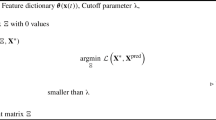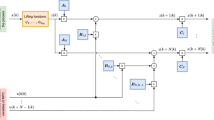Abstract
The assessment of the bounded-input bounded output (BIBO) stability of a dynamic system is of paramount importance in the process control theory and practice. In this paper, we have developed a BIBO stability analysis method for linear time-invariant systems on the basis of Howland’s eigenvalue separation theorem, which involves the matrix sign function, and the Adomian decomposition method. Our proposed method is conceptually convenient and merely requires matrix addition and multiplication. Furthermore, our method eliminates the need for the availability of the system’s characteristic equation, is devoid of any graphical representation, and does not involve the accustomed set of defined rules in the previous approaches. The method’s convergence analysis is presented, and its application is demonstrated through five real-world case studies. Based on a CPU-time analysis, it is demonstrated that the proposed method is computationally superior to the classical Routh–Hurwitz stability test and its efficiency is almost unaffected by the size of the system matrix.



Similar content being viewed by others
References
Bequette W (2003) Process control: modeling, design, and simulation. Prentice Hall, Upper Saddle River
Bubnicki Z (2005) Modern control theory. Springer, Berlin
Homayounzade M (2022) Adaptive robust nonlinear control of spacecraft formation flying: a novel disturbance observer-based control approach. Int J Dyn Control. https://doi.org/10.1007/s40435-021-00898-x
Burns RS (2001) Advanced control engineering. Butterworth-Heinemann, Oxford
Shinners SM (1998) Modern control system theory and design. Wiley, New York
Coughanowr DR, LeBlanc SE (2009) Process systems analysis and control. McGraw-Hill, New York
Marlin TE (2000) Process control: designing processes and control systems for dynamic performance. McGraw-Hill, New York
Higham NJ (2008) Functions of matrices: theory and computation. Society for Industrial and Applied Mathematics (SIAM), Philadelphia
Howland JL (1983) The sign matrix and the separation of matrix eigenvalues. Linear Algebra Appl 49:221–232. https://doi.org/10.1016/0024-3795(83)90104-0
Abbasbandy S (2003) Improving Newton–Raphson method for nonlinear equations by modified Adomian decomposition method. Appl Math Comput 145:887–893. https://doi.org/10.1016/S0096-3003(03)00282-0
Fatoorehchi H, Abolghasemi H (2013) Improving the differential transform method: a novel technique to obtain the differential transforms of nonlinearities by the Adomian polynomials. Appl Math Model 37:6008–6017. https://doi.org/10.1016/j.apm.2012.12.007
Fatoorehchi H, Rach R (2020) A method for inverting the Laplace transforms of two classes of rational transfer functions in control engineering. Alex Eng J 59:4879–4887. https://doi.org/10.1016/j.aej.2020.08.052
Wazwaz AM, El-Sayed SM (2001) A new modification of the Adomian decomposition method for linear and nonlinear operators. Appl Math Comput 122:393–405. https://doi.org/10.1016/S0096-3003(00)00060-6
Fatoorehchi H, Abolghasemi H (2014) Approximating the minimum reflux ratio of multicomponent distillation columns based on the Adomian decomposition method. J Taiwan Inst Chem Eng 45:880–886. https://doi.org/10.1016/j.jtice.2013.09.032
Amooey AA, Montazeri S (2020) Study of transport phenomena of binary distillation via Adomian decomposition method in a vertical wetted-wall column. Heat Mass Transf 56:1045–1050. https://doi.org/10.1007/s00231-019-02756-1
Fatoorehchi H, Abolghasemi H, Rach R (2015) A new parametric algorithm for isothermal flash calculations by the Adomian decomposition of Michaelis–Menten type nonlinearities. Fluid Phase Equilib 395:44–50. https://doi.org/10.1016/j.fluid.2015.03.024
Fatoorehchi H, Abolghasemi H, Rach R (2014) An accurate explicit form of the Hankinson–Thomas–Phillips correlation for prediction of the natural gas compressibility factor. J Petrol Sci Eng 117:46–53. https://doi.org/10.1016/j.petrol.2014.03.004
Fatoorehchi H, Abolghasemi H, Rach R, Assar M (2014) An improved algorithm for calculation of the natural gas compressibility factor via the Hall–Yarborough equation of state. Can J Chem Eng 92:2211–2217. https://doi.org/10.1002/cjce.22054
Fatoorehchi H, Rach R, Tavakoli O, Abolghasemi H (2015) An efficient numerical scheme to solve a quintic equation of state for supercritical fluids. Chem Eng Commun 202:402–407. https://doi.org/10.1080/00986445.2013.843529
Rach R, Duan J-S, Wazwaz A-M (2015) On the solution of non-isothermal reaction-diffusion model equations in a spherical catalyst by the modified Adomian method. Chem Eng Commun 202:1081–1088. https://doi.org/10.1080/00986445.2014.900054
Sun YP, Liu SB, Keith S (2004) Approximate solution for the nonlinear model of diffusion and reaction in porous catalysts by the decomposition method. Chem Eng J 102:1–10. https://doi.org/10.1016/S1385-8947(03)00060-3
Adomian G (1986) Solution of algebraic equations. Math Comput Simulat 28:155–157. https://doi.org/10.1016/0378-4754(86)90110-2
Adomian G (1986) Inversion of matrices. Math Comput Simul 28:151–153. https://doi.org/10.1016/0378-4754(86)90109-6
Adomian G, Rach R (1985) On the solution of algebraic equations by the decomposition method. J Math Anal Appl 105:141–166. https://doi.org/10.1016/0022-247X(85)90102-7
Adomian G, Rach R (1985) Application of the decomposition method to inversion of matrices. J Math Anal Appl 108:409–421. https://doi.org/10.1016/0022-247X(85)90034-4
Adomian G, Rach R (1986) Algebraic computation and the decomposition method. Kybernetes 15:33–37. https://doi.org/10.1108/eb005727
Fatoorehchi H, Abolghasemi H (2014) On computation of real eigenvalues of matrices via the Adomian decomposition. J Egypt Math Soc 22:6–10. https://doi.org/10.1016/j.joems.2013.06.004
Fatoorehchi H, Abolghasemi H (2014) Finding all real roots of a polynomial by matrix algebra and the Adomian decomposition method. J Egypt Math Soc 22:524–528. https://doi.org/10.1016/j.joems.2013.12.018
Adomian G (1994) Solving frontier problems of physics: the decomposition method. Kluwer Academic, Dordrecht
Abbaoui K, Cherruault Y (1994) Convergence of Adomian’s method applied to nonlinear equations. Math Comput Model 20:69–73. https://doi.org/10.1016/0895-7177(94)00163-4
Abdelrazec A, Pelinovsky D (2011) Convergence of the Adomian decomposition method for initial-value problems. Numer Methods Part D Eng 27:749–766. https://doi.org/10.1002/num.20549
Cherruault Y, Adomian G (1993) Decomposition methods: a new proof of convergence. Math Comput Model 18:103–106. https://doi.org/10.1016/0895-7177(93)90233-O
Ouedraogo RZ, Cherruault Y, Abbaoui K (2000) Convergence of Adomian’s method applied to algebraic equations. Kybernetes 29:1298–1305. https://doi.org/10.1108/03684920010346374
Duan JS (2011) Convenient analytic recurrence algorithms for the Adomian polynomials. Appl Math Comput 217:6337–6348. https://doi.org/10.1016/j.amc.2011.01.007
Rach RC (2008) A new definition of the Adomian polynomials. Kybernetes 37:910–955. https://doi.org/10.1108/03684920810884342
Fatoorehchi H, Rach R, Abolghasemi H (2015) A novel family of iterative schemes for computation of matrix inverses by the Adomian decomposition method. Rom J Phys 60:1315–1327
Patra AK, Mishra AK, Rout PK (2020) Backstepping model predictive controller for blood glucose regulation in type-I diabetes patient. IETE J Res 66:326–340. https://doi.org/10.1080/03772063.2018.1493404
Russo LP, Bequette BW (1997) State-space versus input/output representations for cascade control of unstable systems. Ind Eng Chem Res 36:2271–2278. https://doi.org/10.1021/ie960677o
Kendi TA, Doyle FJ (1996) Nonlinear control of a fluidized bed reactor using approximate feedback linearization. Ind Eng Chem Res 35:746–757. https://doi.org/10.1021/ie950334a
Huang CJ, Shieh LS (1976) Modelling large dynamical systems with industrial specifications. Int J Syst Sci 7:241–256. https://doi.org/10.1080/00207727608941914
Satpati B, Koley C, Datta S (2017) Sensor-less predictive drying control of pneumatic conveying batch dryers. IEEE Access 5:3547–3568. https://doi.org/10.1109/ACCESS.2017.2675625
Fatoorehchi H, Gutman I, Abolghasemi H (2015) A combined technique for computation of energy-effect of cycles in conjugated molecules. J Math Chem 53:1113–1125. https://doi.org/10.1007/s10910-015-0473-y
Helmberg G, Wagner P, Veltkamp G (1993) On Faddeev–Leverrier’s method for the computation of the characteristic polynomial of a matrix and of eigenvectors. Linear Algebra Appl 185:219–233. https://doi.org/10.1016/0024-3795(93)90214-9
Tang KT (2007) Mathematical methods for engineers and scientists: complex analysis, determinants and matrices. Springer, Berlin
Hall BC (2015) Lie groups, Lie algebras, and representations: an elementary introduction. Springer, Berlin
Acknowledgements
The first author is grateful to the Center for Nanointegration Duisburg-Essen (CENIDE) of the University of Duisburg-Essen, Germany, for providing him a visiting scientist position for six months. The first author also appreciates the help of Bardiya Fatoorehchi for proof reading the drafts of the manuscript.
Author information
Authors and Affiliations
Corresponding author
Appendix
Appendix
Theorem 1.
Let \({\mathbf{A}} \in M_{n} \left( {\mathbb{C}} \right)\), i.e., \({\mathbf{A}}\) is a square matrix of size \(n\) whose entries can be complex, and assume that \({\mathbf{A}}\) is invertible. It holds that \({\mathbf{A}}^{2}\) and \({\mathbf{A}}^{ - 1}\) are invertible.
Proof
The proof is simple. Since \({\mathbf{A}}\) is invertible, it is nonsingular, and hence \(\det \left( {\mathbf{A}} \right) \ne 0\). Elsewhere [44], we can find the proof of a theorem that states \(\det \left( {{\mathbf{A}} {\mathbf{B}}} \right) = \det \left( {\mathbf{A}} \right)\det \left( {\mathbf{B}} \right)\) for \({\mathbf{A}},{\mathbf{B}} \in M_{n} \left( {\mathbb{C}} \right)\). Consequently, \(\det \left( {{\mathbf{A}}^{2} } \right) = \left[ {\det \left( {\mathbf{A}} \right)} \right]^{{ 2}} \ne 0\). This concludes that \({\mathbf{A}}^{2}\) is invertible. Additionally, from the aforementioned theorem, it follows that \(\det \left( {{\mathbf{A}}^{ - 1} } \right) = {1 \mathord{\left/ {\vphantom {1 {\det \left( {\mathbf{A}} \right)}}} \right. \kern-\nulldelimiterspace} {\det \left( {\mathbf{A}} \right)}}\) by considering \({\mathbf{A}} {\mathbf{A}}^{ - 1} = {\mathbf{I}}\) and taking \({\mathbf{B}} = {\mathbf{A}}^{ - 1}\), where \({\mathbf{I}}\) is the identity matrix. Now, because \(\det \left( {\mathbf{A}} \right) \ne 0\), it is yielded that \(\det \left( {{\mathbf{A}}^{ - 1} } \right) \ne 0\); Thus, \({\mathbf{A}}^{ - 1}\) is invertible.
Theorem 2.
Let \({\mathbf{A}} \in M_{n} \left( {\mathbb{C}} \right)\) be invertible. It holds that \({\mathbf{A}}^{\frac{1}{2}}\) is invertible.
Proof
If we take \({\mathbf{B}} = {\mathbf{A}}^{\frac{1}{2}}\), then we can write that
Then, it follows that
or equrivalently,
Now, since \(\det \left( {\mathbf{A}} \right) \ne 0\), it is straightforward that \(\det \left( {\mathbf{B}} \right) \ne 0\) or in other words, \({\mathbf{A}}^{\frac{1}{2}}\) is invertible.
Theorem 3.
Let \({\mathbf{A}} \in M_{n} \left( {\mathbb{C}} \right)\) be invertible. It holds that \({\mathbf{A}}\) has a square root, i.e., a matrix \({\mathbf{T}} \in M_{n} \left( {\mathbb{C}} \right)\) such that \({\mathbf{T}}^{{ 2}} = {\mathbf{A}}\).
Proof
Our proof is based on the fact that every invertible matrix can be expressed as the exponential of some other matrix, which is because the matrix exponential function is a surjective map.
from the space of all square matrices of size \(n\) to the group of all \(n \times n\) invertible matrices [45].
As a result, we write that
Clearly, by definition, \({\mathbf{T}} = e^{{ \frac{{\mathbf{M}}}{2}}}\) is one possible square root of \({\mathbf{A}}\).
Rights and permissions
About this article
Cite this article
Fatoorehchi, H., Djilali, S. Stability analysis of linear time-invariant dynamic systems using the matrix sign function and the Adomian decomposition method. Int. J. Dynam. Control 11, 593–604 (2023). https://doi.org/10.1007/s40435-022-00989-3
Received:
Revised:
Accepted:
Published:
Issue Date:
DOI: https://doi.org/10.1007/s40435-022-00989-3




